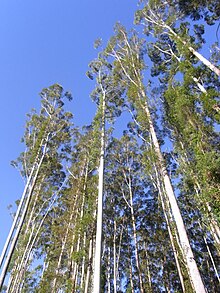Eucalyptus grandis
| flooded gum, rose gum | |
|---|---|
 |
|
| Eucalyptus grandis at Kerewong State Forest, Australia | |
| Scientific classification | |
| Kingdom: | Plantae |
| (unranked): | Angiosperms |
| (unranked): | Eudicots |
| (unranked): | Rosids |
| Order: | Myrtales |
| Family: | Myrtaceae |
| Genus: | Eucalyptus |
| Species: | E. grandis |
| Binomial name | |
|
Eucalyptus grandis W. Hill ex Maiden |
|
 |
|
| E. grandis, field distribution | |
Eucalyptus grandis, commonly known as the flooded gum or rose gum, is a tall tree with smooth bark, rough at the base fibrous or flaky, grey to grey-brown. At maturity, it reaches 50 metres (160 feet) tall, though the largest specimens can exceed 80 metres (260 feet) tall. It is found on coastal areas and sub-coastal ranges from Newcastle in New South Wales northwards to west of Daintree in Queensland, mainly on flat land and lower slopes, where it is the dominant tree of wet forests and on the margins of rain forests.
Eucalyptus grandis was first described by W. Hill in 1862. The species name grandis "large" relates to this tree's large size. It is commonly known as the flooded gum, and is also called rose gum in Queensland. It has been classified in the subgenus Symphyomyrtus, Section Latoangulatae, Series Transversae (eastern blue gums) by Brooker and Kleinig. Its two closest relatives are the Sydney blue gum (Eucalyptus saligna) and the mountain blue gum (E. deanei).
Eucalyptus grandis grows as a straight and tall forest tree, reaching around 50 m (160 ft) tall, with a dbh of 1.2 to 2 m (3.9 to 6.6 ft). The biggest trees can reach 75 m (246 ft) high and 3 m (9.8 ft) dbh, the tallest recorded known as "The Grandis" near Bulahdelah, with a height of 86 m (282 ft) and a girth of 8.5 m (28 ft). The bole is straight for 2/3rds to 3/4 the height of the tree. The bark is smooth and powdery, pale- or blue-grey to white in colour, with a skirt of rough brownish bark for the bottom 1–4 m of the tree trunk. The glossy dark green leaves are stalked, lanceolate to broad lanceolate, and paler on their undersides, 10 to 16 cm (3.9 to 6.3 in) long and 2–3 cm (0.79–1.18 in) wide. They are arranged alternately along the branches. The secondary veins arise off the leaf midvein at a wide angle (61 degrees), and the leaf is dotted with around 800 oil glands per square centimetre.
The white flowers appear from mid autumn to late winter from April to August, and are arranged in groups of seven to eleven flowerheads. The flowers are followed by small pear- or cone-shaped gumnuts which measure 5–8 mm in length and 4–7 mm across.
...
Wikipedia
